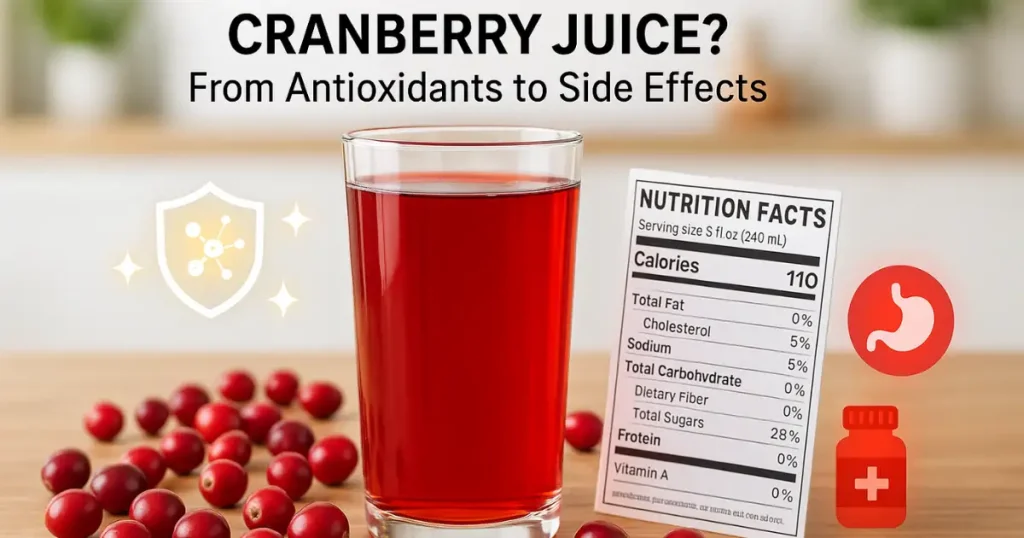
Introduction
Cranberry juice is often marketed as a super-drink—celebrated for its antioxidants, urinary tract health benefits, and refreshing tart taste. But do you really know what’s in that bottle of cranberry juice sitting in your fridge?
While cranberry juice can offer genuine health benefits, not all cranberry juices are created equal. Some are packed with added sugars, artificial flavors, or barely contain real cranberry content at all.
In this comprehensive article we’ll dive deep into the ingredients, benefits, and side effects of cranberry juice. We’ll also break down how to choose the healthiest options and avoid hidden health risks..
What Exactly Is Cranberry Juice?
Cranberry juice is made from the cranberry fruit, a tart, red berry native to North America. Due to its natural bitterness, pure cranberry juice is often blended with apple juice, grape juice, added sugar, or water to make it more palatable.
There are three main types of cranberry juice on the market:
- 100% Pure Cranberry Juice – No added sugar, very tart.
- Cranberry Juice Cocktail – Sweetened with sugar or high-fructose corn syrup.
- Cranberry Juice Blends – Mixed with other juices like apple or grape.
Important Note: Many brands labeled “cranberry juice” are only 5–27% actual cranberry juice. The rest is usually filler juice or added sugars.
Nutritional Facts: What’s in 1 Cup (240ml) of 100% Cranberry Juice?
- Calories: 116
- Sugars: 31g (mostly natural, some added)
- Vitamin C: 26% of Daily Value
- Vitamin E: 20% DV
- Vitamin K1: 11% DV
- Antioxidants: High levels (flavonoids, proanthocyanidins)
- Fiber: 0g (fiber is mostly removed during juicing)
Note: Nutritional content varies drastically between pure juice and sweetened cocktails.
Top 7 Health Benefits of Cranberry Juice
1. Supports Urinary Tract Health
This is cranberry juice’s most famous claim. The juice contains proanthocyanidins, which help prevent E. coli bacteria from sticking to the urinary tract walls, reducing the risk of UTIs (urinary tract infections).
🔬 Scientific Backing:
A 2023 review in Advances in Nutrition confirmed cranberry juice reduced UTI recurrence, especially in women with frequent infections.
2. Rich in Antioxidants
Cranberries are loaded with flavonoids, quercetin, and polyphenols, which:
- Combat oxidative stress
- Protect against cellular aging
- Reduce inflammation
These antioxidants may help protect against heart disease, cancer, and brain degeneration.
3. Boosts Heart Health
Some studies suggest that drinking low-sugar cranberry juice can:
- Lower LDL (“bad”) cholesterol
- Increase HDL (“good”) cholesterol
- Improve arterial flexibility
This is due to the presence of polyphenols, which protect blood vessels and reduce oxidative damage.
4. Aids in Digestive Health
Cranberry compounds may:
- Inhibit the growth of Helicobacter pylori, the bacteria linked to stomach ulcers
- Promote a healthy gut microbiome
However, more research is needed to solidify this benefit in daily use.
5. Supports Immune Function
Thanks to its high vitamin C and E content, cranberry juice can help:
- Strengthen the immune response
- Reduce inflammation
- Fight off viral and bacterial infections
6. Potential Cancer-Fighting Properties
In lab studies, cranberry extract has shown activity against:
- Breast cancer
- Colon cancer
- Prostate cancer
The antioxidants may prevent the growth of tumor cells, though human trials are limited.
7. Oral Health Benefits
Cranberry juice may help prevent plaque formation and gum disease by reducing bacterial adhesion in the mouth—similar to its effect in the urinary tract.
But Here’s the Catch: Hidden Health Risks
Not all cranberry juices are healthy. In fact, many commercial versions may do more harm than good. Here’s what to watch for:
1. High Sugar Content
Some cranberry juice products have as much sugar as soda. A typical “cranberry juice cocktail” contains:
- 28–35 grams of sugar per 8 oz
- That’s about 7–9 teaspoons of sugar
🚫 Risk: Excess sugar intake is linked to:
- Obesity
- Type 2 diabetes
- Fatty liver disease
- Heart disease
Tip: Always read the label. Choose “No Added Sugar” or “100% Pure Cranberry Juice.”
2. Kidney Stone Risk
Cranberries are high in oxalates, compounds that can contribute to calcium oxalate kidney stones—especially in those already at risk.
✔️ Advice: Drink in moderation and increase water intake if prone to kidney stones.
3. Drug Interactions
Cranberry juice may interact with:
- Warfarin (Coumadin) – increasing the risk of bleeding
- Aspirin – some people with salicylate sensitivity may react
- Statins – may enhance side effects in rare cases
✅ Always check with a healthcare provider if you’re on medication.
4. Gastrointestinal Discomfort
Some people report:
- Bloating
- Diarrhea
- Acid reflux
This is more common when drinking large quantities or sweetened versions.
Who Should Avoid or Limit Cranberry Juice?
- People with diabetes (choose unsweetened versions only)
- Those with a history of kidney stones
- People on blood thinners
- Children (due to high sugar in commercial juices)
- Individuals with GERD or acid reflux
How to Choose the Healthiest Cranberry Juice
🛒 Shopping Checklist:
- ✅ Look for “100% cranberry juice” (not “juice cocktail”)
- ✅ No added sugars or high-fructose corn syrup
- ✅ Organic or cold-pressed varieties are best
- ✅ Short ingredient list (just cranberry juice + water)
🚫 Avoid:
- Labels that say “juice blend”
- Artificial sweeteners like sucralose or acesulfame potassium
- Juice made “from concentrate” with additives
Healthier Alternatives & Tips
If pure cranberry juice is too tart for you:
- Dilute with water or sparkling water
- Mix with apple or orange juice (50/50) – use natural juices only
- Use cranberry extract supplements if you’re targeting UTIs
- Add to smoothies with natural sweet fruits like banana or mango
Cranberry Juice vs. Cranberry Supplements
| Feature | Juice | Supplements |
| Taste | Tart or sweet | Tasteless capsule |
| Sugar Content | Often high | Zero |
| Convenience | Requires refrigeration | Travel-friendly |
| UTI Prevention | Backed by research | Also backed, sometimes stronger |
| Antioxidants | Moderate | ften concentrated |
Verdict: Fr general health, juice is fine in moderation. For targeted support (like frequent UTIs), standardized supplements may be more effective and safer.requently Asked Questions (FAQs)
1: Is cranberry juice good to drink every day?
es—in moderation. 4–8 oz daily of unsweetened juice can offer benefits. Avoid overconsumption due to sugar and oxalates.
Q2: Does cranberry juice detox your body?
ere’s no strong scientific evidence supporting “detox” claims. However, its antioxidants and hydration support your body’s natural detox rocesses.
3: Can cranberry juice cure UTIs?
o, but it may help prevent recurring UTIs. It’s not a replacement for antibiotics in active infections.
4: What is the best time to drink cranberry juice?
Morning or between meals is ideal. Avoid drinking late at night due to its acidity and sugar content.
inal Verdict: Is Cranberry Juice Healthy?
es—but only when chosen and consumed wisely. Here’s the summary:
✅ Health Benefits:
🚫 Health Risks:
Bottom Line:
Go for 100% pure cranberry juice, drink in moderation, and always read labels. If you’re looking for consistent therapeutic benefits (like for UTIs), consider cranberry supplements after consulting your healthcare provider.
Share This Knowledge
Loved this deep dive? Share it with your friends and family who think cranberry juice is just another sugary drink. Help them make smarter, althier choices with confidence.



